climate control FORD EDGE 2021 User Guide
[x] Cancel search | Manufacturer: FORD, Model Year: 2021, Model line: EDGE, Model: FORD EDGE 2021Pages: 500, PDF Size: 8.52 MB
Page 166 of 500
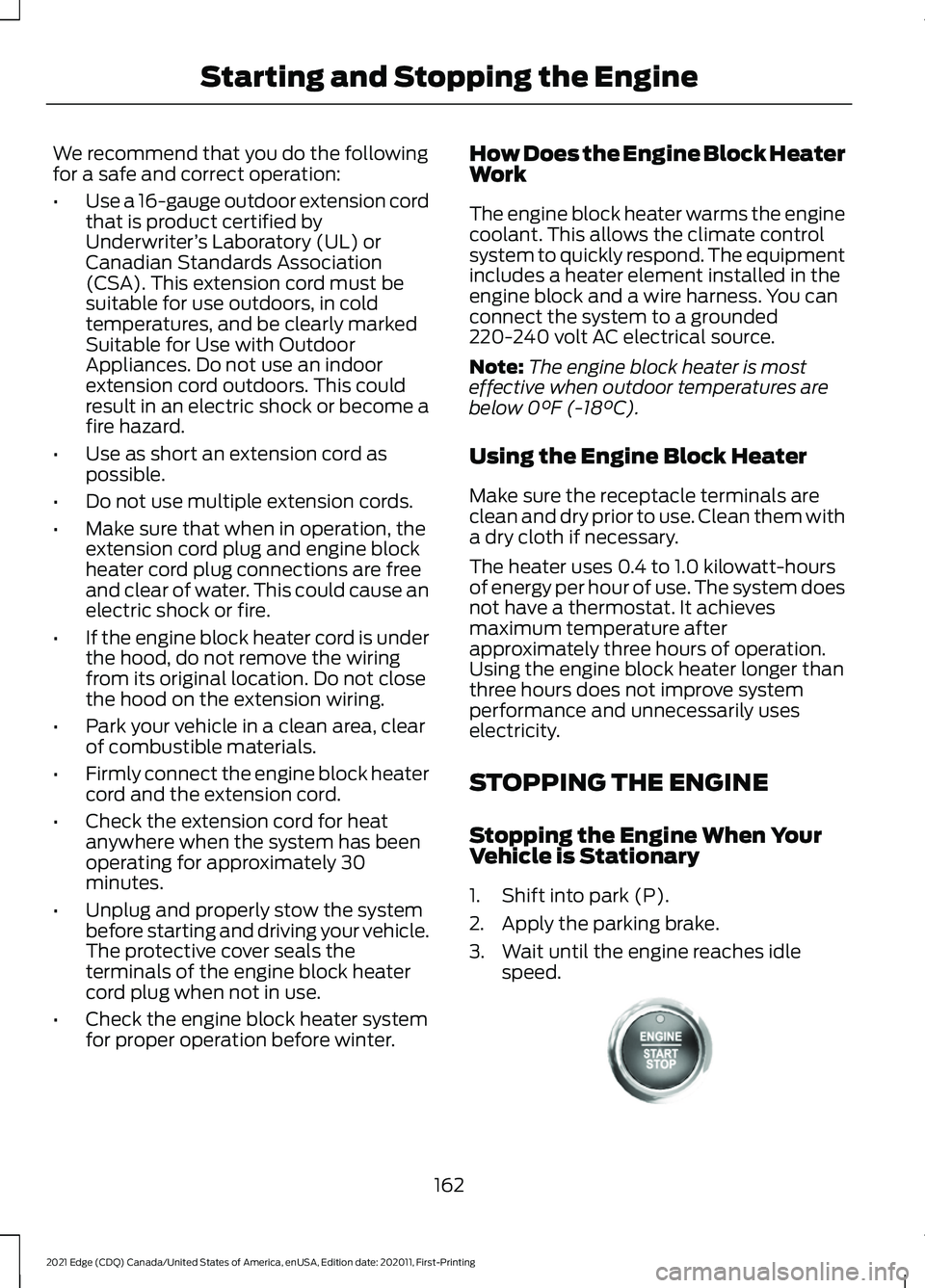
We recommend that you do the following
for a safe and correct operation:
•
Use a 16-gauge outdoor extension cord
that is product certified by
Underwriter ’s Laboratory (UL) or
Canadian Standards Association
(CSA). This extension cord must be
suitable for use outdoors, in cold
temperatures, and be clearly marked
Suitable for Use with Outdoor
Appliances. Do not use an indoor
extension cord outdoors. This could
result in an electric shock or become a
fire hazard.
• Use as short an extension cord as
possible.
• Do not use multiple extension cords.
• Make sure that when in operation, the
extension cord plug and engine block
heater cord plug connections are free
and clear of water. This could cause an
electric shock or fire.
• If the engine block heater cord is under
the hood, do not remove the wiring
from its original location. Do not close
the hood on the extension wiring.
• Park your vehicle in a clean area, clear
of combustible materials.
• Firmly connect the engine block heater
cord and the extension cord.
• Check the extension cord for heat
anywhere when the system has been
operating for approximately 30
minutes.
• Unplug and properly stow the system
before starting and driving your vehicle.
The protective cover seals the
terminals of the engine block heater
cord plug when not in use.
• Check the engine block heater system
for proper operation before winter. How Does the Engine Block Heater
Work
The engine block heater warms the engine
coolant. This allows the climate control
system to quickly respond. The equipment
includes a heater element installed in the
engine block and a wire harness. You can
connect the system to a grounded
220-240 volt AC electrical source.
Note:
The engine block heater is most
effective when outdoor temperatures are
below 0°F (-18°C).
Using the Engine Block Heater
Make sure the receptacle terminals are
clean and dry prior to use. Clean them with
a dry cloth if necessary.
The heater uses 0.4 to 1.0 kilowatt-hours
of energy per hour of use. The system does
not have a thermostat. It achieves
maximum temperature after
approximately three hours of operation.
Using the engine block heater longer than
three hours does not improve system
performance and unnecessarily uses
electricity.
STOPPING THE ENGINE
Stopping the Engine When Your
Vehicle is Stationary
1. Shift into park (P).
2. Apply the parking brake.
3. Wait until the engine reaches idle speed. 162
2021 Edge (CDQ) Canada/United States of America, enUSA, Edition date: 202011, First-Printing Starting and Stopping the EngineE321258
Page 274 of 500
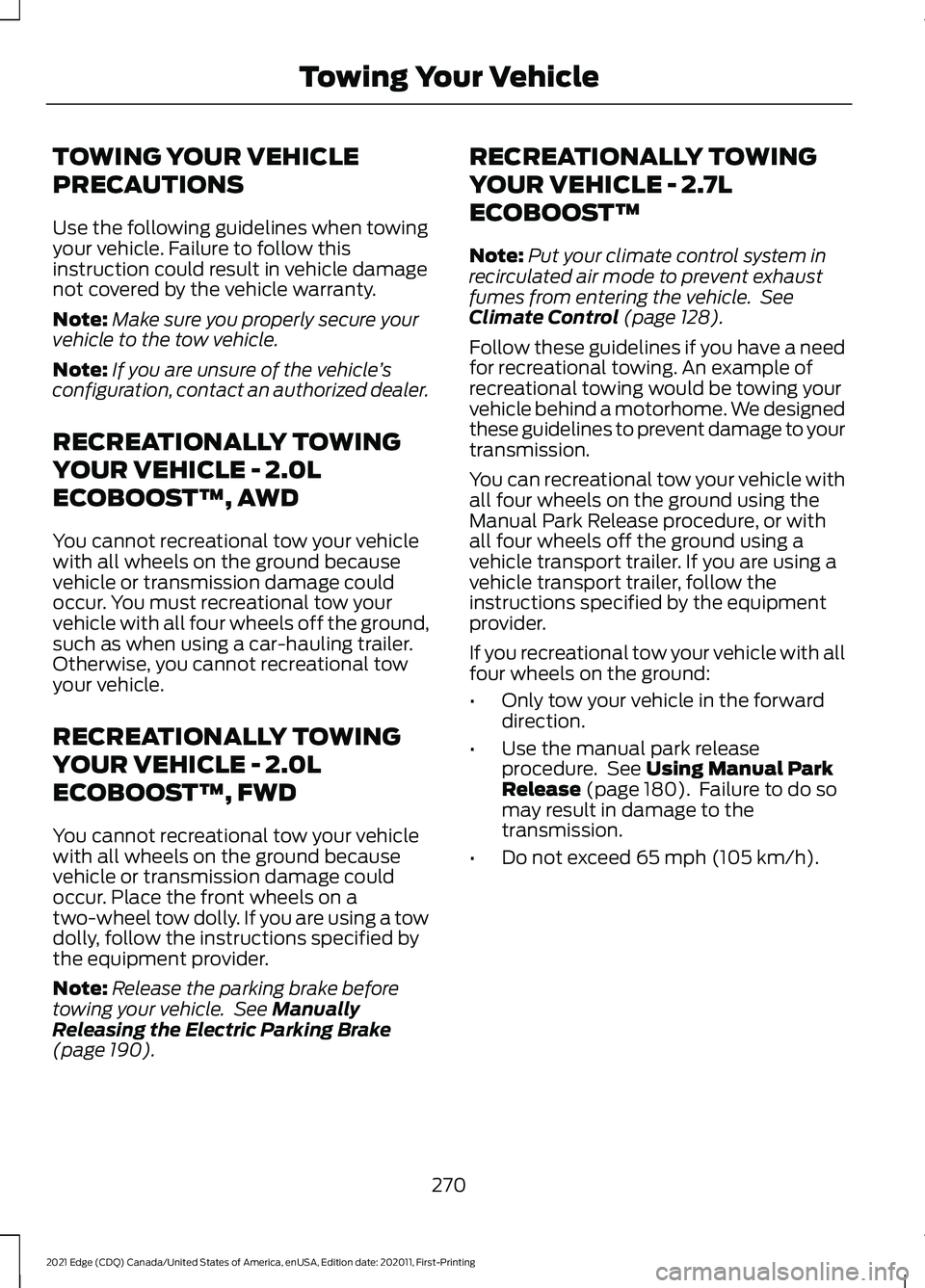
TOWING YOUR VEHICLE
PRECAUTIONS
Use the following guidelines when towing
your vehicle. Failure to follow this
instruction could result in vehicle damage
not covered by the vehicle warranty.
Note:
Make sure you properly secure your
vehicle to the tow vehicle.
Note: If you are unsure of the vehicle ’s
configuration, contact an authorized dealer.
RECREATIONALLY TOWING
YOUR VEHICLE - 2.0L
ECOBOOST™, AWD
You cannot recreational tow your vehicle
with all wheels on the ground because
vehicle or transmission damage could
occur. You must recreational tow your
vehicle with all four wheels off the ground,
such as when using a car-hauling trailer.
Otherwise, you cannot recreational tow
your vehicle.
RECREATIONALLY TOWING
YOUR VEHICLE - 2.0L
ECOBOOST™, FWD
You cannot recreational tow your vehicle
with all wheels on the ground because
vehicle or transmission damage could
occur. Place the front wheels on a
two-wheel tow dolly. If you are using a tow
dolly, follow the instructions specified by
the equipment provider.
Note: Release the parking brake before
towing your vehicle. See Manually
Releasing the Electric Parking Brake
(page
190). RECREATIONALLY TOWING
YOUR VEHICLE - 2.7L
ECOBOOST™
Note:
Put your climate control system in
recirculated air mode to prevent exhaust
fumes from entering the vehicle. See
Climate Control
(page 128).
Follow these guidelines if you have a need
for recreational towing. An example of
recreational towing would be towing your
vehicle behind a motorhome. We designed
these guidelines to prevent damage to your
transmission.
You can recreational tow your vehicle with
all four wheels on the ground using the
Manual Park Release procedure, or with
all four wheels off the ground using a
vehicle transport trailer. If you are using a
vehicle transport trailer, follow the
instructions specified by the equipment
provider.
If you recreational tow your vehicle with all
four wheels on the ground:
• Only tow your vehicle in the forward
direction.
• Use the manual park release
procedure. See
Using Manual Park
Release (page 180). Failure to do so
may result in damage to the
transmission.
• Do not exceed
65 mph (105 km/h).
270
2021 Edge (CDQ) Canada/United States of America, enUSA, Edition date: 202011, First-Printing Towing Your Vehicle
Page 289 of 500
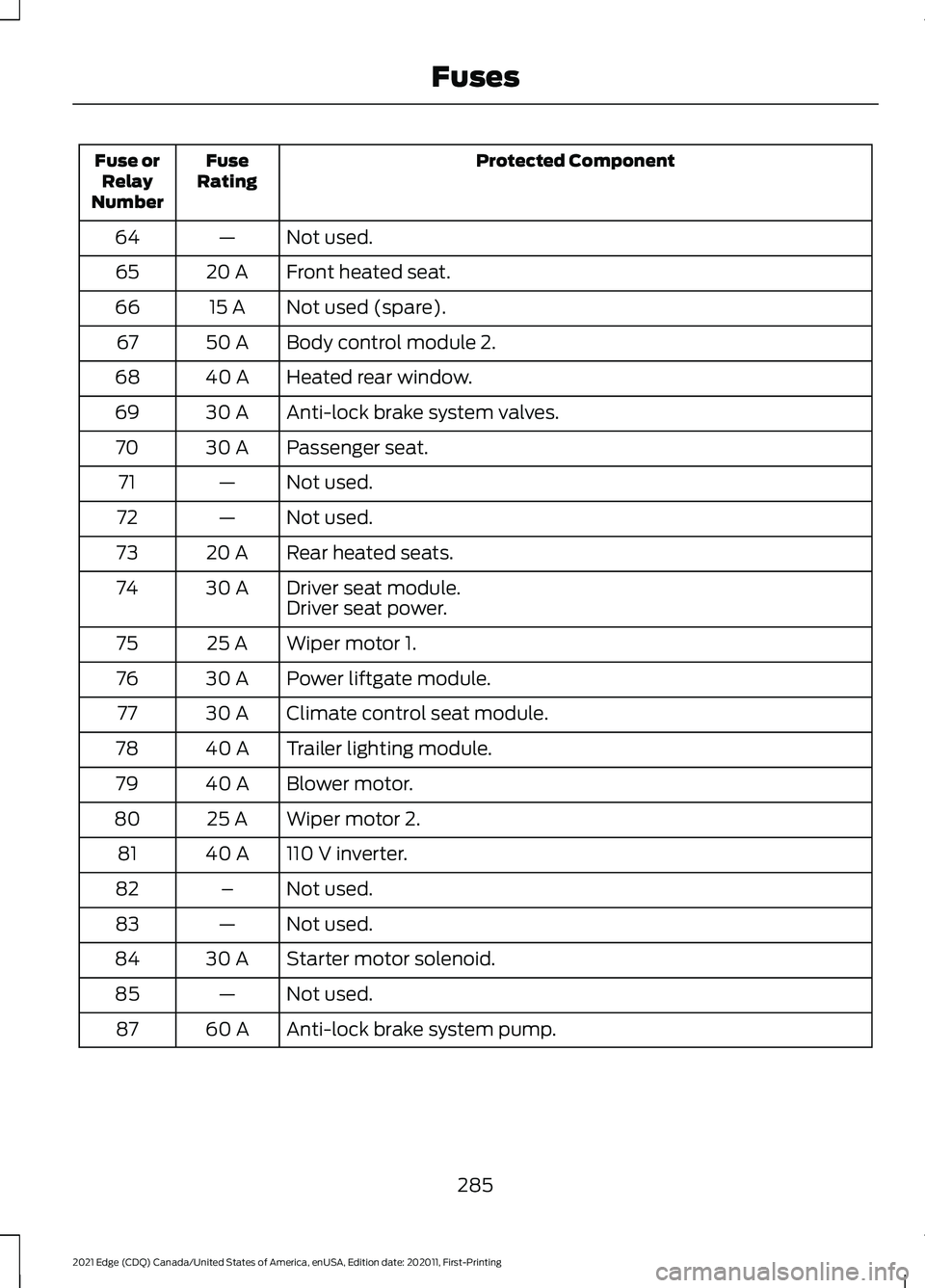
Protected Component
Fuse
Rating
Fuse or
Relay
Number
Not used.
—
64
Front heated seat.
20 A
65
Not used (spare).
15 A
66
Body control module 2.
50 A
67
Heated rear window.
40 A
68
Anti-lock brake system valves.
30 A
69
Passenger seat.
30 A
70
Not used.
—
71
Not used.
—
72
Rear heated seats.
20 A
73
Driver seat module.
30 A
74
Driver seat power.
Wiper motor 1.
25 A
75
Power liftgate module.
30 A
76
Climate control seat module.
30 A
77
Trailer lighting module.
40 A
78
Blower motor.
40 A
79
Wiper motor 2.
25 A
80
110 V inverter.
40 A
81
Not used.
–
82
Not used.
—
83
Starter motor solenoid.
30 A
84
Not used.
—
85
Anti-lock brake system pump.
60 A
87
285
2021 Edge (CDQ) Canada/United States of America, enUSA, Edition date: 202011, First-Printing Fuses
Page 292 of 500
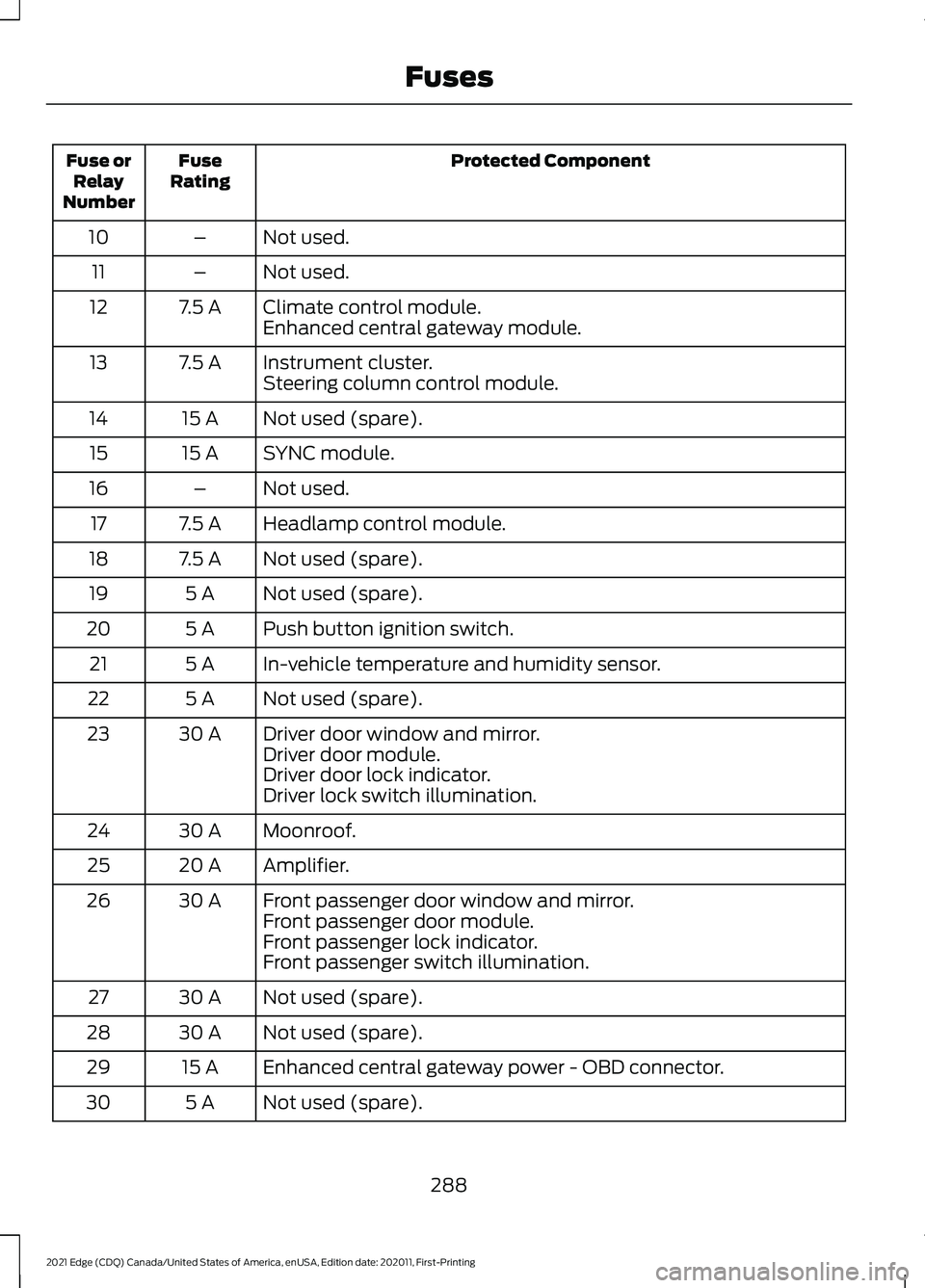
Protected Component
Fuse
Rating
Fuse or
Relay
Number
Not used.
–
10
Not used.
–
11
Climate control module.
7.5 A
12
Enhanced central gateway module.
Instrument cluster.
7.5 A
13
Steering column control module.
Not used (spare).
15 A
14
SYNC module.
15 A
15
Not used.
–
16
Headlamp control module.
7.5 A
17
Not used (spare).
7.5 A
18
Not used (spare).
5 A
19
Push button ignition switch.
5 A
20
In-vehicle temperature and humidity sensor.
5 A
21
Not used (spare).
5 A
22
Driver door window and mirror.
30 A
23
Driver door module.
Driver door lock indicator.
Driver lock switch illumination.
Moonroof.
30 A
24
Amplifier.
20 A
25
Front passenger door window and mirror.
30 A
26
Front passenger door module.
Front passenger lock indicator.
Front passenger switch illumination.
Not used (spare).
30 A
27
Not used (spare).
30 A
28
Enhanced central gateway power - OBD connector.
15 A
29
Not used (spare).
5 A
30
288
2021 Edge (CDQ) Canada/United States of America, enUSA, Edition date: 202011, First-Printing Fuses
Page 305 of 500
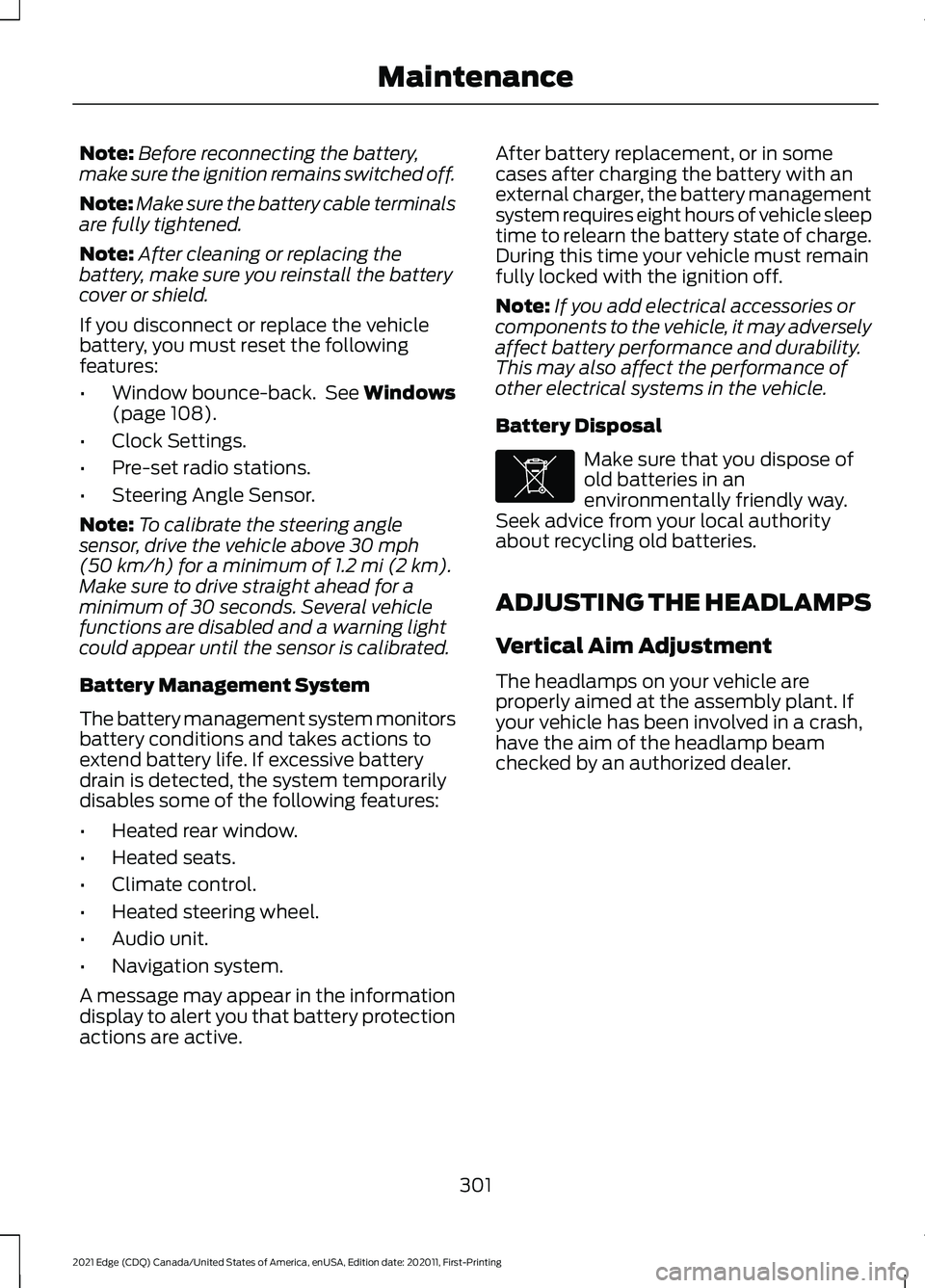
Note:
Before reconnecting the battery,
make sure the ignition remains switched off.
Note: Make sure the battery cable terminals
are fully tightened.
Note: After cleaning or replacing the
battery, make sure you reinstall the battery
cover or shield.
If you disconnect or replace the vehicle
battery, you must reset the following
features:
• Window bounce-back. See Windows
(page 108).
• Clock Settings.
• Pre-set radio stations.
• Steering Angle Sensor.
Note: To calibrate the steering angle
sensor, drive the vehicle above
30 mph
(50 km/h) for a minimum of 1.2 mi (2 km).
Make sure to drive straight ahead for a
minimum of 30 seconds. Several vehicle
functions are disabled and a warning light
could appear until the sensor is calibrated.
Battery Management System
The battery management system monitors
battery conditions and takes actions to
extend battery life. If excessive battery
drain is detected, the system temporarily
disables some of the following features:
• Heated rear window.
• Heated seats.
• Climate control.
• Heated steering wheel.
• Audio unit.
• Navigation system.
A message may appear in the information
display to alert you that battery protection
actions are active. After battery replacement, or in some
cases after charging the battery with an
external charger, the battery management
system requires eight hours of vehicle sleep
time to relearn the battery state of charge.
During this time your vehicle must remain
fully locked with the ignition off.
Note:
If you add electrical accessories or
components to the vehicle, it may adversely
affect battery performance and durability.
This may also affect the performance of
other electrical systems in the vehicle.
Battery Disposal Make sure that you dispose of
old batteries in an
environmentally friendly way.
Seek advice from your local authority
about recycling old batteries.
ADJUSTING THE HEADLAMPS
Vertical Aim Adjustment
The headlamps on your vehicle are
properly aimed at the assembly plant. If
your vehicle has been involved in a crash,
have the aim of the headlamp beam
checked by an authorized dealer.
301
2021 Edge (CDQ) Canada/United States of America, enUSA, Edition date: 202011, First-Printing MaintenanceE107998
Page 317 of 500
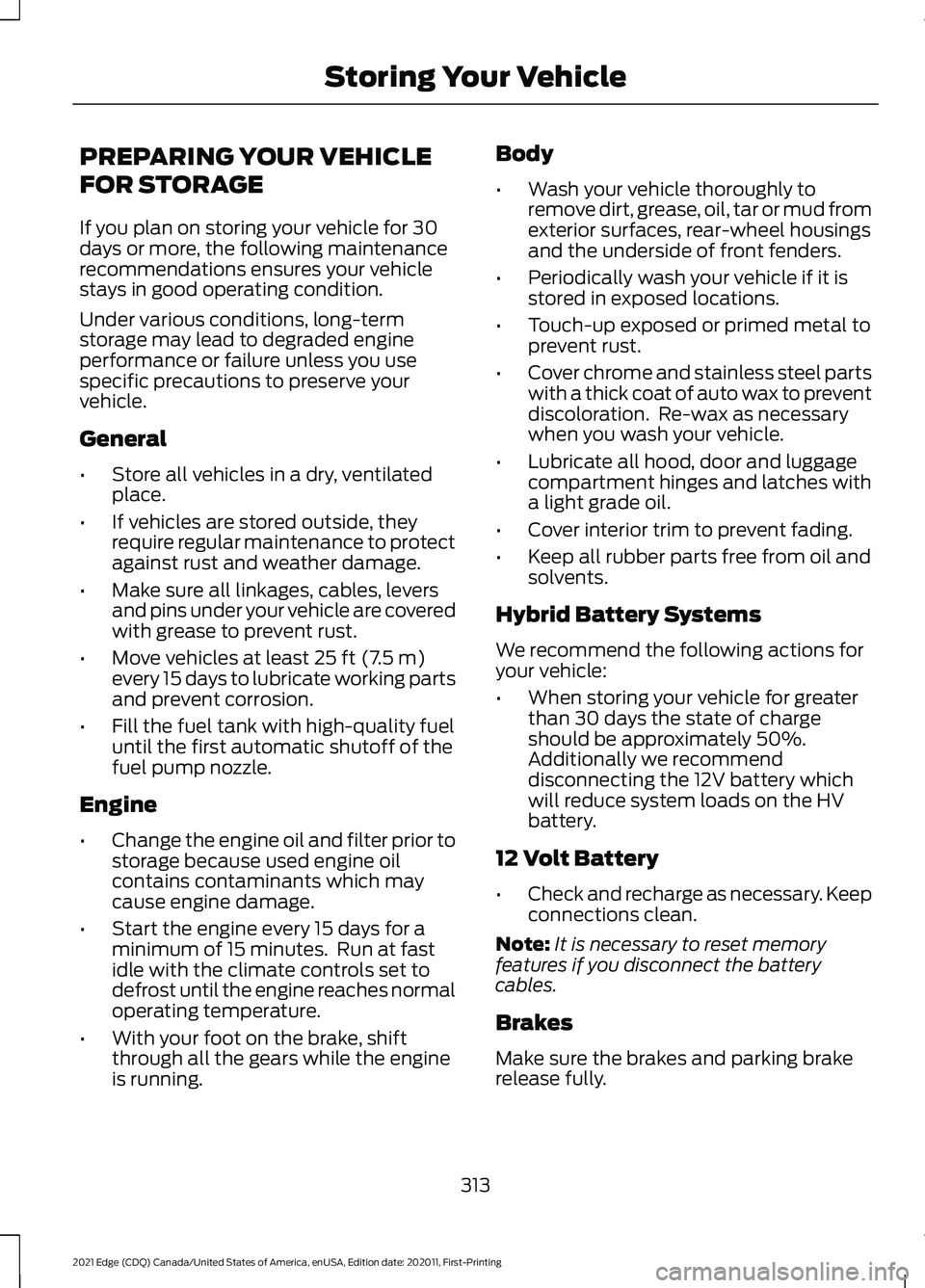
PREPARING YOUR VEHICLE
FOR STORAGE
If you plan on storing your vehicle for 30
days or more, the following maintenance
recommendations ensures your vehicle
stays in good operating condition.
Under various conditions, long-term
storage may lead to degraded engine
performance or failure unless you use
specific precautions to preserve your
vehicle.
General
•
Store all vehicles in a dry, ventilated
place.
• If vehicles are stored outside, they
require regular maintenance to protect
against rust and weather damage.
• Make sure all linkages, cables, levers
and pins under your vehicle are covered
with grease to prevent rust.
• Move vehicles at least 25 ft (7.5 m)
every 15 days to lubricate working parts
and prevent corrosion.
• Fill the fuel tank with high-quality fuel
until the first automatic shutoff of the
fuel pump nozzle.
Engine
• Change the engine oil and filter prior to
storage because used engine oil
contains contaminants which may
cause engine damage.
• Start the engine every 15 days for a
minimum of 15 minutes. Run at fast
idle with the climate controls set to
defrost until the engine reaches normal
operating temperature.
• With your foot on the brake, shift
through all the gears while the engine
is running. Body
•
Wash your vehicle thoroughly to
remove dirt, grease, oil, tar or mud from
exterior surfaces, rear-wheel housings
and the underside of front fenders.
• Periodically wash your vehicle if it is
stored in exposed locations.
• Touch-up exposed or primed metal to
prevent rust.
• Cover chrome and stainless steel parts
with a thick coat of auto wax to prevent
discoloration. Re-wax as necessary
when you wash your vehicle.
• Lubricate all hood, door and luggage
compartment hinges and latches with
a light grade oil.
• Cover interior trim to prevent fading.
• Keep all rubber parts free from oil and
solvents.
Hybrid Battery Systems
We recommend the following actions for
your vehicle:
• When storing your vehicle for greater
than 30 days the state of charge
should be approximately 50%.
Additionally we recommend
disconnecting the 12V battery which
will reduce system loads on the HV
battery.
12 Volt Battery
• Check and recharge as necessary. Keep
connections clean.
Note: It is necessary to reset memory
features if you disconnect the battery
cables.
Brakes
Make sure the brakes and parking brake
release fully.
313
2021 Edge (CDQ) Canada/United States of America, enUSA, Edition date: 202011, First-Printing Storing Your Vehicle
Page 319 of 500
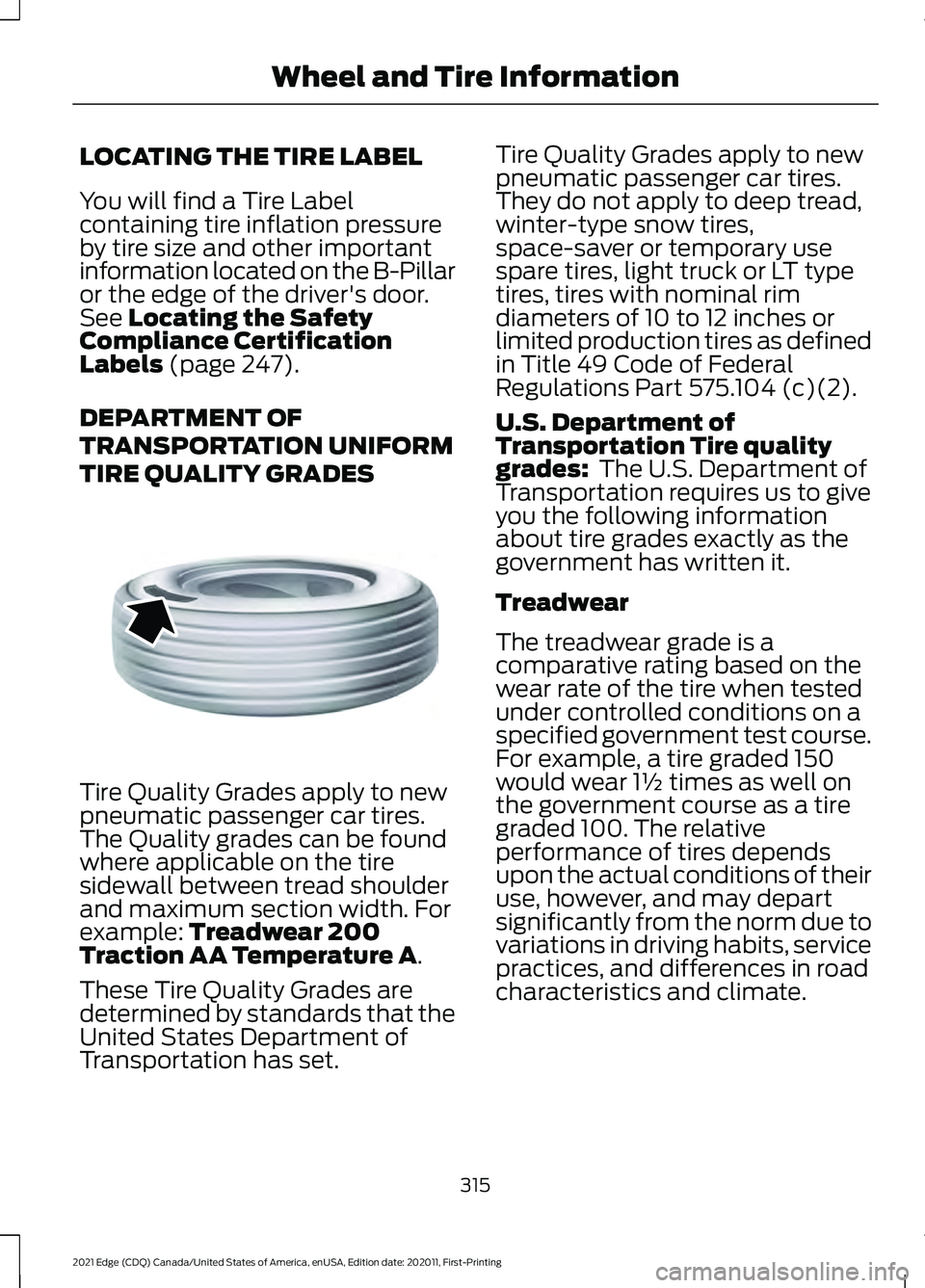
LOCATING THE TIRE LABEL
You will find a Tire Label
containing tire inflation pressure
by tire size and other important
information located on the B-Pillar
or the edge of the driver's door.
See Locating the Safety
Compliance Certification
Labels
(page 247).
DEPARTMENT OF
TRANSPORTATION UNIFORM
TIRE QUALITY GRADES Tire Quality Grades apply to new
pneumatic passenger car tires.
The Quality grades can be found
where applicable on the tire
sidewall between tread shoulder
and maximum section width. For
example:
Treadwear 200
Traction AA Temperature A.
These Tire Quality Grades are
determined by standards that the
United States Department of
Transportation has set. Tire Quality Grades apply to new
pneumatic passenger car tires.
They do not apply to deep tread,
winter-type snow tires,
space-saver or temporary use
spare tires, light truck or LT type
tires, tires with nominal rim
diameters of 10 to 12 inches or
limited production tires as defined
in Title 49 Code of Federal
Regulations Part 575.104 (c)(2).
U.S. Department of
Transportation Tire quality
grades:
The U.S. Department of
Transportation requires us to give
you the following information
about tire grades exactly as the
government has written it.
Treadwear
The treadwear grade is a
comparative rating based on the
wear rate of the tire when tested
under controlled conditions on a
specified government test course.
For example, a tire graded 150
would wear 1½ times as well on
the government course as a tire
graded 100. The relative
performance of tires depends
upon the actual conditions of their
use, however, and may depart
significantly from the norm due to
variations in driving habits, service
practices, and differences in road
characteristics and climate.
315
2021 Edge (CDQ) Canada/United States of America, enUSA, Edition date: 202011, First-Printing Wheel and Tire InformationE142542
Page 477 of 500
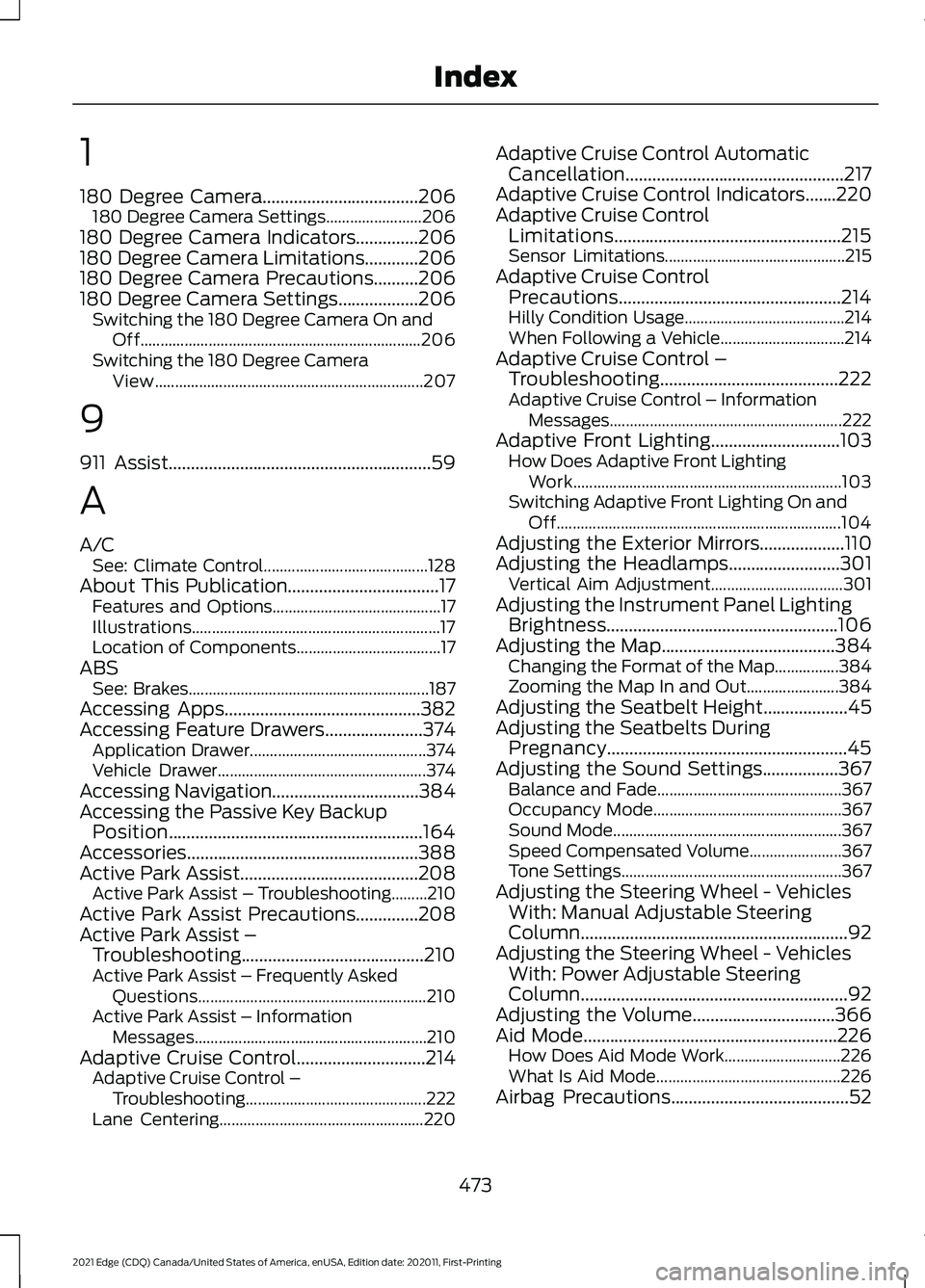
1
180 Degree Camera...................................206
180 Degree Camera Settings........................ 206
180 Degree Camera Indicators..............206
180 Degree Camera Limitations............206
180 Degree Camera Precautions..........206
180 Degree Camera Settings..................206 Switching the 180 Degree Camera On and
Off...................................................................... 206
Switching the 180 Degree Camera View................................................................... 207
9
911 Assist...........................................................59
A
A/C See: Climate Control......................................... 128
About This Publication..................................17 Features and Options.......................................... 17
Illustrations.............................................................. 17
Location of Components.................................... 17
ABS See: Brakes............................................................ 187
Accessing Apps............................................382
Accessing Feature Drawers......................374 Application Drawer............................................ 374
Vehicle Drawer.................................................... 374
Accessing Navigation.................................384
Accessing the Passive Key Backup Position.........................................................164
Accessories....................................................388
Active Park Assist........................................208 Active Park Assist – Troubleshooting.........210
Active Park Assist Precautions
..............208
Active Park Assist – Troubleshooting.........................................210
Active Park Assist – Frequently Asked Questions......................................................... 210
Active Park Assist – Information Messages.......................................................... 210
Adaptive Cruise Control
.............................214
Adaptive Cruise Control –
Troubleshooting............................................. 222
Lane Centering................................................... 220Adaptive Cruise Control Automatic
Cancellation.................................................217
Adaptive Cruise Control Indicators.......220
Adaptive Cruise Control Limitations...................................................215
Sensor Limitations............................................. 215
Adaptive Cruise Control Precautions..................................................214
Hilly Condition Usage........................................ 214
When Following a Vehicle............................... 214
Adaptive Cruise Control – Troubleshooting
........................................222
Adaptive Cruise Control – Information
Messages.......................................................... 222
Adaptive Front Lighting
.............................103
How Does Adaptive Front Lighting
Work................................................................... 103
Switching Adaptive Front Lighting On and Off....................................................................... 104
Adjusting the Exterior Mirrors...................110
Adjusting the Headlamps.........................301 Vertical Aim Adjustment................................. 301
Adjusting the Instrument Panel Lighting Brightness....................................................106
Adjusting the Map.......................................384 Changing the Format of the Map................384
Zooming the Map In and Out....................... 384
Adjusting the Seatbelt Height
...................45
Adjusting the Seatbelts During Pregnancy......................................................45
Adjusting the Sound Settings.................367 Balance and Fade.............................................. 367
Occupancy Mode............................................... 367
Sound Mode......................................................... 367
Speed Compensated Volume....................... 367
Tone Settings....................................................... 367
Adjusting the Steering Wheel - Vehicles With: Manual Adjustable Steering
Column............................................................92
Adjusting the Steering Wheel - Vehicles With: Power Adjustable Steering
Column............................................................92
Adjusting the Volume
................................366
Aid Mode.........................................................226
How Does Aid Mode Work............................. 226
What Is Aid Mode.............................................. 226
Airbag Precautions
........................................52
473
2021 Edge (CDQ) Canada/United States of America, enUSA, Edition date: 202011, First-Printing Index
Page 478 of 500
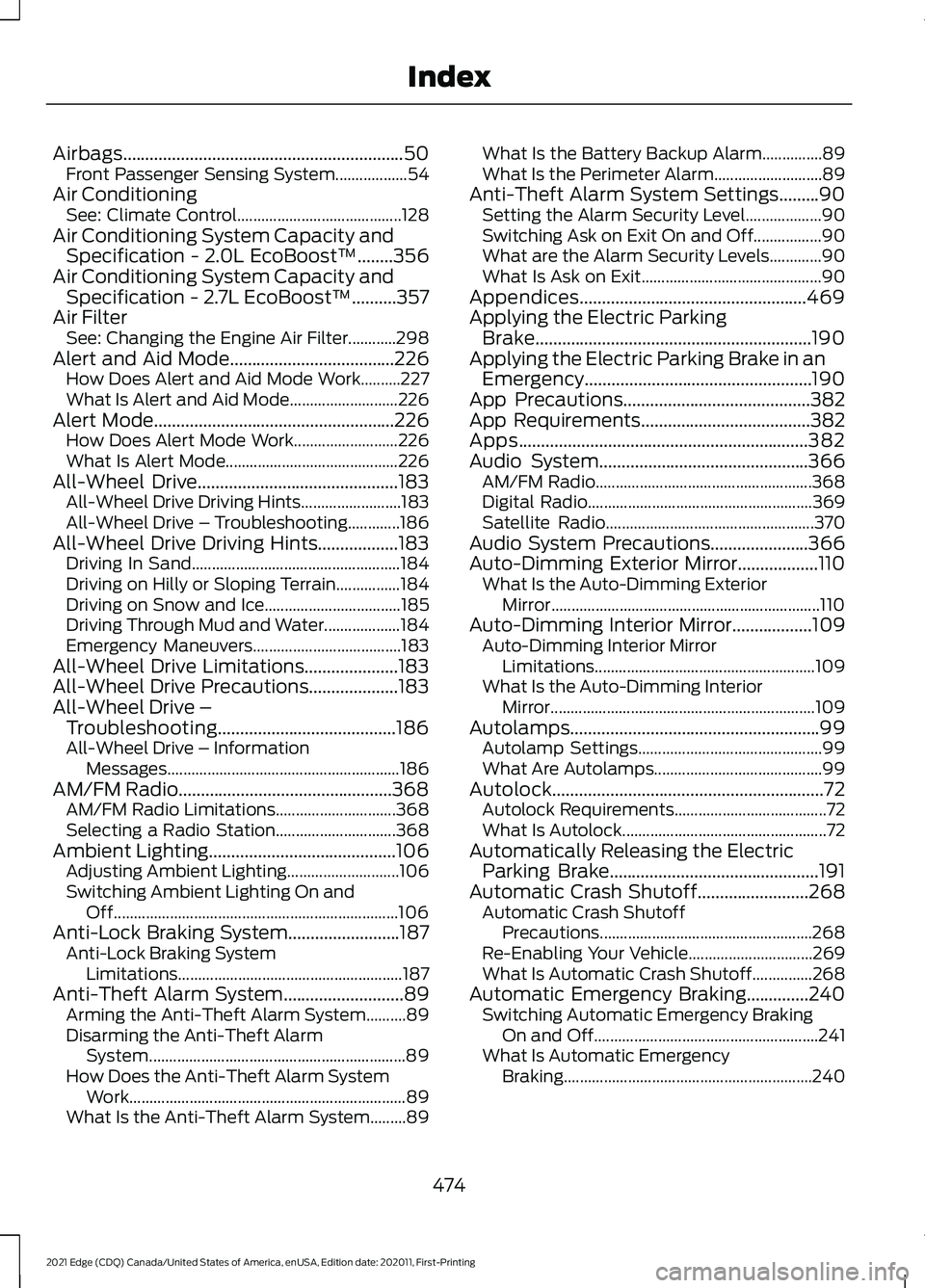
Airbags...............................................................50
Front Passenger Sensing System.................. 54
Air Conditioning See: Climate Control......................................... 128
Air Conditioning System Capacity and Specification - 2.0L EcoBoost™........356
Air Conditioning System Capacity and Specification - 2.7L EcoBoost™
..........357
Air Filter See: Changing the Engine Air Filter............298
Alert and Aid Mode.....................................226 How Does Alert and Aid Mode Work..........227
What Is Alert and Aid Mode........................... 226
Alert Mode
......................................................226
How Does Alert Mode Work.......................... 226
What Is Alert Mode........................................... 226
All-Wheel Drive
.............................................183
All-Wheel Drive Driving Hints......................... 183
All-Wheel Drive – Troubleshooting.............186
All-Wheel Drive Driving Hints..................183 Driving In Sand.................................................... 184
Driving on Hilly or Sloping Terrain................184
Driving on Snow and Ice.................................. 185
Driving Through Mud and Water................... 184
Emergency Maneuvers..................................... 183
All-Wheel Drive Limitations.....................183
All-Wheel Drive Precautions
....................183
All-Wheel Drive – Troubleshooting........................................186
All-Wheel Drive – Information Messages.......................................................... 186
AM/FM Radio................................................368 AM/FM Radio Limitations.............................. 368
Selecting a Radio Station.............................. 368
Ambient Lighting
..........................................106
Adjusting Ambient Lighting............................ 106
Switching Ambient Lighting On and Off....................................................................... 106
Anti-Lock Braking System.........................187 Anti-Lock Braking System
Limitations........................................................ 187
Anti-Theft Alarm System
...........................89
Arming the Anti-Theft Alarm System..........89
Disarming the Anti-Theft Alarm
System................................................................ 89
How Does the Anti-Theft Alarm System Work..................................................................... 89
What Is the Anti-Theft Alarm System.........89 What Is the Battery Backup Alarm...............89
What Is the Perimeter Alarm...........................
89
Anti-Theft Alarm System Settings.........90 Setting the Alarm Security Level................... 90
Switching Ask on Exit On and Off.................90
What are the Alarm Security Levels.............90
What Is Ask on Exit............................................. 90
Appendices...................................................469
Applying the Electric Parking Brake..............................................................190
Applying the Electric Parking Brake in an Emergency...................................................190
App Precautions
..........................................382
App Requirements......................................382
Apps
.................................................................382
Audio System...............................................366 AM/FM Radio...................................................... 368
Digital Radio........................................................ 369
Satellite Radio.................................................... 370
Audio System Precautions......................366
Auto-Dimming Exterior Mirror..................110 What Is the Auto-Dimming Exterior
Mirror................................................................... 110
Auto-Dimming Interior Mirror..................109 Auto-Dimming Interior Mirror
Limitations....................................................... 109
What Is the Auto-Dimming Interior Mirror
.................................................................. 109
Autolamps........................................................99 Autolamp Settings.............................................. 99
What Are Autolamps.......................................... 99
Autolock.............................................................72 Autolock Requirements...................................... 72
What Is Autolock................................................... 72
Automatically Releasing the Electric Parking Brake
...............................................191
Automatic Crash Shutoff.........................268 Automatic Crash Shutoff
Precautions ..................................................... 268
Re-Enabling Your Vehicle............................... 269
What Is Automatic Crash Shutoff...............268
Automatic Emergency Braking..............240 Switching Automatic Emergency Braking
On and Off........................................................ 241
What Is Automatic Emergency Braking.............................................................. 240
474
2021 Edge (CDQ) Canada/United States of America, enUSA, Edition date: 202011, First-Printing Index
Page 480 of 500
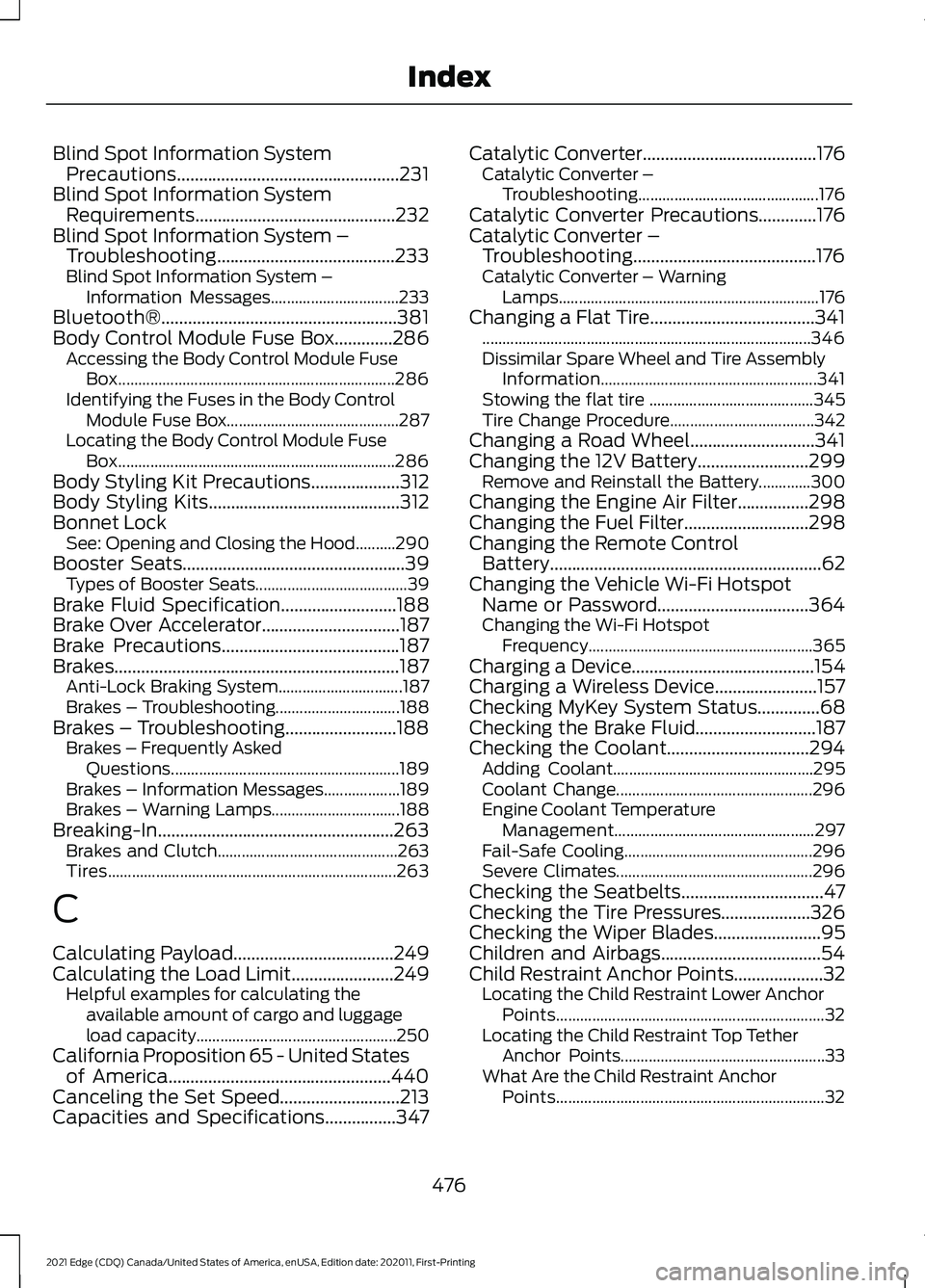
Blind Spot Information System
Precautions..................................................231
Blind Spot Information System Requirements.............................................232
Blind Spot Information System – Troubleshooting........................................233
Blind Spot Information System – Information Messages................................ 233
Bluetooth®.....................................................381
Body Control Module Fuse Box.............286 Accessing the Body Control Module Fuse
Box..................................................................... 286
Identifying the Fuses in the Body Control Module Fuse Box........................................... 287
Locating the Body Control Module Fuse Box..................................................................... 286
Body Styling Kit Precautions....................312
Body Styling Kits...........................................312
Bonnet Lock See: Opening and Closing the Hood..........290
Booster Seats
..................................................39
Types of Booster Seats...................................... 39
Brake Fluid Specification
..........................188
Brake Over Accelerator...............................187
Brake Precautions........................................187
Brakes................................................................187 Anti-Lock Braking System............................... 187
Brakes – Troubleshooting............................... 188
Brakes – Troubleshooting.........................188 Brakes – Frequently Asked
Questions......................................................... 189
Brakes – Information Messages................... 189
Brakes – Warning Lamps................................ 188
Breaking-In.....................................................263 Brakes and Clutch............................................. 263
Tires........................................................................\
263
C
Calculating Payload
....................................249
Calculating the Load Limit.......................249
Helpful examples for calculating the
available amount of cargo and luggage
load capacity.................................................. 250
California Proposition 65 - United States of America
..................................................440
Canceling the Set Speed...........................213
Capacities and Specifications................347 Catalytic Converter.......................................176
Catalytic Converter –
Troubleshooting............................................. 176
Catalytic Converter Precautions
.............176
Catalytic Converter – Troubleshooting.........................................176
Catalytic Converter – Warning Lamps................................................................. 176
Changing a Flat Tire.....................................341 ........................................................................\
.......... 346
Dissimilar Spare Wheel and Tire Assembly Information...................................................... 341
Stowing the flat tire ......................................... 345
Tire Change Procedure.................................... 342
Changing a Road Wheel
............................341
Changing the 12V Battery.........................299 Remove and Reinstall the Battery.............300
Changing the Engine Air Filter................298
Changing the Fuel Filter............................298
Changing the Remote Control Battery.............................................................62
Changing the Vehicle Wi-Fi Hotspot Name or Password..................................364
Changing the Wi-Fi Hotspot Frequency........................................................ 365
Charging a Device
.........................................154
Charging a Wireless Device.......................157
Checking MyKey System Status
..............68
Checking the Brake Fluid...........................187
Checking the Coolant................................294 Adding Coolant.................................................. 295
Coolant Change................................................. 296
Engine Coolant Temperature Management.................................................. 297
Fail-Safe Cooling............................................... 296
Severe Climates................................................. 296
Checking the Seatbelts................................47
Checking the Tire Pressures....................326
Checking the Wiper Blades........................95
Children and Airbags....................................54
Child Restraint Anchor Points....................32 Locating the Child Restraint Lower Anchor
Points................................................................... 32
Locating the Child Restraint Top Tether Anchor Points................................................... 33
What Are the Child Restraint Anchor Points................................................................... 32
476
2021 Edge (CDQ) Canada/United States of America, enUSA, Edition date: 202011, First-Printing Index